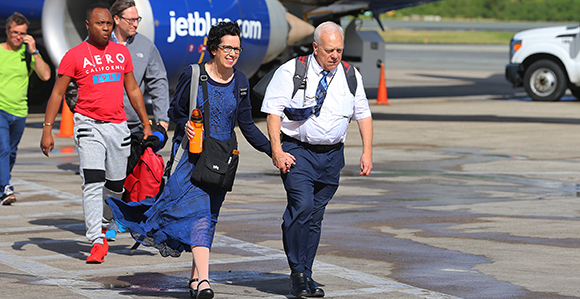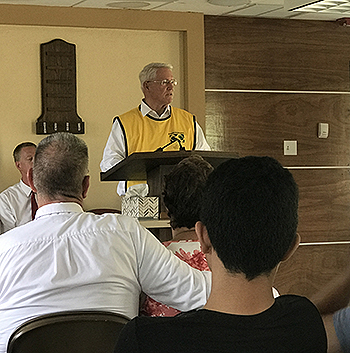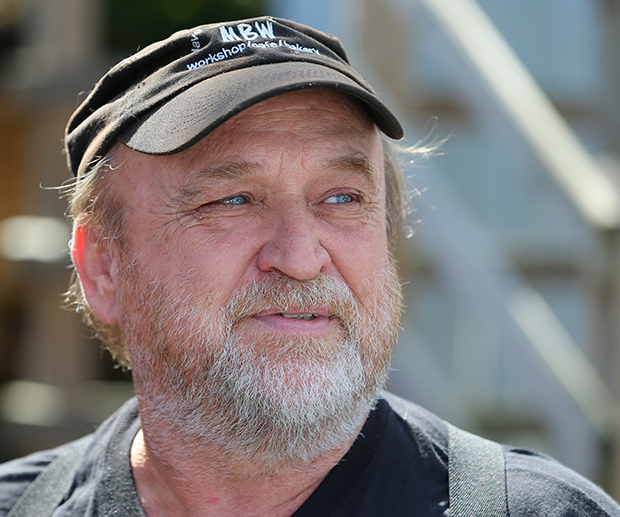Senior Missionaries, LDS Charities, and Nonprofit Organizations Unify to Recover the Caribbean
Contributed By Scott Taylor, Church News contributor

Elder Win Duersch and Sister Karen Duersch from Orem, Utah, walk off of the plane at the St. Thomas airport as they return to continue their mission.
Article Highlights
- After Hurricanes Irma and Maria, senior missionary couples, LDS Charities, and other nonprofit organizations are uniting to recover the Caribbean.
“The members are strong here, no doubt about it. They are helping each other and those around them. We have a good reputation in the neighborhoods where our members live because of the good works, donations, time, and money spent helping get things back to normal.” —Steve Richards, St. Thomas Branch President
Related Links
ST. THOMAS, U.S. VIRGIN ISLANDS
Outside the secure baggage-claim area of St. Thomas’s Cyril E. King International Airport, a man and a woman scan passengers coming in from Puerto Rico on a 34-minute Monday morning flight on February 19 between the two U.S. territory islands in the Caribbean. The couple wait to greet a trio of passenger pairs arriving for different reasons, but all three as a result of last September’s devastating hurricanes Irma and Maria.
One twosome is a senior missionary couple, returning to their Puerto Rico San Juan Mission assignment after fortuitously leaving the Caribbean the day before the first storm, Hurricane Irma. Another pair represents LDS Charities and Church welfare concerns, checking on how previous hurricane relief donations have been used on St. Thomas and what ongoing needs may be assisted. And the third is two journalists documenting an update on the island’s recovery.
The host couple—St. Thomas Branch President Steve Richards and his wife, Kim Richards—welcome the three pairs, first directing the two missionaries and their five pieces of luggage to a waiting mission vehicle. Then they load up in their SUV with the other four visitors, who have six hours to survey the lingering damage and witness recovery efforts before returning to San Juan on an afternoon flight.
As they drive through the territorial capital city of Charlotte Amalie and across much of the 32-square-mile island, the Richardses point out still-damaged public buildings and private homes, stop by the recently refurbished LDS meetinghouse, and make stops to meet with LDS Charities relief partners.
Returning missionaries
In the Puerto Rico San Juan Mission, nearly all of the missionaries serving on outlying islands besides Puerto Rico are senior couples; Elder Win Duersch and Sister Karen Duersch from Orem, Utah, were assigned to Tortola of the British Virgin Islands. But just before Irma hit, the Duersches took a temporary-leave trip to Washington to be with an ailing granddaughter hovering near death.
After learning of Irma’s toll on Tortola and the rest of the U.S. and British Virgin Islands while in Washington, the Duersches didn’t know if they had anything to return to, with no prompt return in sight.
With all the missionaries from Puerto Rico and outlying islands evacuated and reassigned elsewhere in the United States, Elder and Sister Duersch were “recruited” from their Washington stay by a son serving as a stake president in Reading, Pennsylvania, to be assigned to his Allentown (Spanish) Ward. The Duersches served in Allentown for three months, with a number of the ward members attending there having Caribbean roots.

Members of the St. Thomas Branch gather for an October 2017 sacrament meeting at the home of Branch President Steven Richards. The branch’s meetinghouse was severely damaged during Hurricane Irma and was closed for several months for repairs. Photo by Scott G Winterton, Deseret News.
When missionaries started returning to the Puerto Rico San Juan Mission, plans were made for the Duersches to return to Tortola, where their apartment and their belongings survived relatively unscathed. But there was a twist—they were also being assigned to serve on St. Thomas as well, with an apartment provided there and a plan to serve alternate weeks on the two neighboring islands, ferrying back and forth.
“There weren’t plans for us to return,” said Sister Duersch, once on St. Thomas, “but we’re where the Lord needs us to be.”
Meetinghouse and members

Hurricane Irma’s high winds toppled the steeple of the St. Thomas Branch meetinghouse. Photo by Scott G Winterton, Deseret News.
After making annual work trips to St. Thomas for a dozen years, Steve Richards decided to relocate his wife and the three youngest of their eight children to the island, where he works as controller for a local company selling and servicing boats and outboard motors.
In September, they prayerfully prepared for their first major hurricane. The parking-by-prompting of their SUV, a mission vehicle, and a friend’s car near their home resulted in debris falling all around—but not on top of—the three cars. And their home weathered Irma relatively well, with only limited water damage.
“But we were so naïve,” Kim Richards said. “We walked out the front door (after the storm) and saw that a whole home nearby was missing.”
So was St. Thomas’s lush, green appearance. Aerial photos after Irma showed the island looking like a brown desert—the brown wasn’t sand or dirt, but rather the bare branches, limbs, and trunks of the island’s defoliated trees.
The Richards home may have gone relatively unscathed, but many of the residential and public buildings across the islands didn’t fare as well, including the LDS meetinghouse among the handful of other places of worship located on what is known as “Church Hill.” Irma’s winds peeled off about a quarter of the meetinghouse’s roof tiles, took out the three large palms in the front, toppled and smashed the glass backboards in the parking lot, and rearranged the steeple.
Steve Richards had his wife and kids return to the United States just days after Irma while he stayed and focused on the branch members and others on the island. No Latter-day Saints were among the island’s four fatalities, but two had lost their residences and others suffered extensive damages.
LDS tourists from the mainland (who had visited the branch the Sunday before Irma and who ended up being holed up in a local hotel for days after because of the damage) returned home and set up a GoFundMe online account for branch members, surpassing its $10,000 goal. The money went to buy food for members and their neighbors, supplies to repair damaged homes and cars, and gas for the generators as power outages continued for up to four months.
President Henry B. Eyring, Second Counselor in the First Presidency, made a brief stop on St. Thomas a week after the initial hurricane, visiting members and the meetinghouse during his post-Irma trip to encourage affected Church members in the Caribbean and Florida. Soon after, Maria’s downpour drenched the damaged meetinghouse, soaking sections of wallboard and interior studs and resulting in black mold.
“Irma did most of the damage, and then Maria came in and flooded it all,” Steve Richards said, describing not just the meetinghouse but the impact across the island.
At first, the branch held its Sunday meetings at the Richards’s home, which doubled as a makeshift shelter for some displaced members and friends. Later, the branch rented a room at a local school, with Primary held out on a picnic table and priesthood inside a gazebo.
Kim Richards and the kids returned four months after the hurricanes, and the meetinghouse has been refurbished and reopened, with a Friday night branch activity preceding the first Sunday meetings held there on February 18.
What hadn’t returned to normalcy were the branch numbers, with branch membership hovering just above 100 with a number of member families and individuals having left battered St. Thomas for the United States. Prior to the hurricanes, branch attendance was averaging 48 members and 24 visitors—mostly tourists—per Sunday; after the storms and through February, the averages dipped to 25 members and two visitors.
LDS Charities and welfare

Bishop Dean M. Davies, First Counselor in the Presiding Bishopric, offerings comfort and counsel to members of the St. Thomas Branch.
Key to the six-hour itinerary were visits to local relief organizations having received assistance donations from partnering with LDS Charities. Directing the visits were Ty Johnson, LDS Charities director of emergency response, and Julio Acosta, the area welfare manager for the Church’s Caribbean Area and an Area Seventy from the Dominican Republic.
Representative of such partner visits was a stop at My Brother’s Workshop, a nonprofit charitable organization providing at-risk and high-risk young people on the island mentoring, counseling, paid job training, education, and job placement. LDS Charities has helped provide wood, as well as other materials and equipment.
Scott Bradley, a retired manufacturing engineer in Maine who moved to St. Thomas 12 years ago, founded My Brother’s Workshop and serves as its program director. It has expanded from a woodworking shop on St. Thomas to now include a bakery and café, an online school, an online radio station, and a second woodshop on neighboring St. Croix.
In 10 years, the organization has helped some 1,500 young people, said Bradley, adding that the U.S. Virgin Islands ranks high globally in youth crime and violence statistics. “We had one kid—his history caught up to him,” he recalled of a former program participant. “He was gunned down and robbed—and we made the casket for him because his family couldn’t afford it.”
Since the hurricanes, the bakery and café has served tens of thousands of meals. Meanwhile, the woodshop has halted the manufacturing of benches, tables, custom furniture, and handcrafted gifts—in part because it was without power until electricity was finally restored in February—with work crews sent out across the island to repair roofs and clean up and remove debris.
Declining offers for paying jobs to do recovery work, My Brother’s Workshop rather has focused on providing services and using donated materials to help seniors and low- or no-income households. “We can’t turn our backs on them,” Bradley said.
Which was not lost on Johnson, mindful of LDS Charities having provided wood and other materials and equipment. “What I love is that you’re not only helping the kids,” he told Bradley, “but that they’re in turn helping the less advantaged. It’s a win-win.”
Epilogue
With their luggage loaded into the mission vehicle that the Richardses had brought that Monday morning to the airport parking lot, Elder and Sister Duersch drive off to resume their missionary service on the islands.
Ty Johnson and Julio Acosta finish their last partner visit in Charlotte Amalie, visiting the St. Thomas office of the American Red Cross before flying back to San Juan and then on the next day to St. Maarten in a series of similar partner visits throughout the area.
And after dropping their visitors off at the airport, the Richardses return to family, work, and Church service—as much of a normal life as possible on a Caribbean island on the road to recovery from pair a of devastating hurricanes.
With the branch back at the restored meetinghouse, several member families have returned and there’s a noticeable uptick in attendance. The branch even visited the Santo Domingo Dominican Republic Temple recently to make up for a temple trip scrapped by last fall’s hurricanes.
“I was wondering if I was called to preside over the dissolution of our branch—but the Lord had other ideas and we now are getting back to a flourishing state where we are doing rather well,” said Steve Richards.
“The members are strong here, no doubt about it. They are helping each other and those around them. We have a good reputation in the neighborhoods where our members live because of the good works, donations, time, and money spent helping get things back to normal.”

Members of the St. Thomas Branch gather on the steps of the Santo Domingo Dominican Republic Temple in late February 2018. September 2017 hurricanes and resulting damages scrubbed a planned branch temple trip in the fall of 2017. Photo courtesy of Steve Richards.

Scott Bradley, founder of My Brother’s Workshop, talks with LDS Church officials on St. Thomas, U.S. Virgin Islands. Photo by Scott G Winterton, Deseret News.

St. Thomas Branch President Steve Richards and Julio Acosta, the area welfare manager for the Church’s Caribbean Area and an Area Seventy from the Dominican Republic, look out over a hillside of damaged homes. Photo by Scott G Winterton, Deseret News.

St. Thomas Branch President Steve Richards and his wife, Kim Richards, join Ty Johnson, LDS Charities director of emergency response, and Julio Acosta, the area welfare manager for the Church’s Caribbean Area and an Area Seventy from the Dominican Republic, as they talk with Scott Bradley, the founder of My Brother’s Workshop. Photo by Scott G Winterton, Deseret News.

Jonathan Tuel, site manager for My Brother’s Workshop on St. Thomas, U.S. Virgin Islands, gives information about the work they do as he talks with St. Thomas Branch President Steve Richards and his wife, Kim Richards. Photo by Scott G Winterton, Deseret News.

St. Thomas Branch President Steve Richards shows the newly repaired Church meetinghouse. Photo by Scott G Winterton, Deseret News.

Storm-damaged homes on a hillside on St. Thomas, U.S. Virgin Islands. Photo by Scott G Winterton, Deseret News.

A severely damaged church on St. Thomas, U.S. Virgin Islands. Photo by Scott G Winterton, Deseret News.

A damaged home on St. Thomas from Hurricane Irma in September 2017. Photo by Scott G Winterton, Deseret News.

Newly planted palm trees line Magens Bay Beach on St. Thomas in the U.S. Virgin Islands. Photo by Scott G Winterton, Deseret News.

President Henry B. Eyring flew into San Juan, Puerto Rico, to meet with and comfort Latter-day Saints and survey the damage caused by Hurricane Irma. Photo by Scott Taylor.
